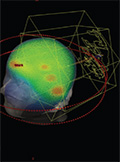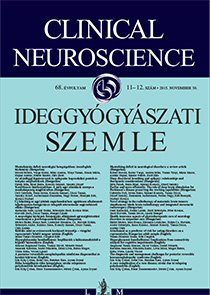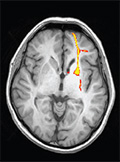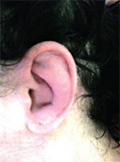The eLitMed.hu medical portal uses computer cookies for convenient operation. Detailed information can be found in the Cookie-policy.
Clinical Neuroscience - 2015;68(11-12)
Content
[Mentalizing deficit in neurological disorders: a review article]
[Introduction – Mentalization is the ability to attribute mental states (intentions, desires, thoughts, emotions) to others, and hence to predict their behaviour. This ability fundamentally determines our participation in social relationships and adaptation to society. A significant proportion of the disorders of the central nervous system (CNS) affects those brain structures and neurotransmitter systems that play a role in the mentalizing processes. Accordingly, a number of CNS disorders may be associated with mentalizing deficits, which may affect the outcome of these diseases. Here, we review recent research on mentalizing abilities in neurological diseases. Methods – An internet database search was performed to identify publications on the subject. Results – Sixty-two publications in English corresponded to the search criteria. These publications reported impaired mentalization in several neurological disorders (e.g. epilepsy, Parkinson’s disease, multiple sclerosis, dementias, traumatic brain injury). Discussion – The results indicate that a number of neurological disorders associate with mentalizing deficit. This deficit is often present in the early stages of the diseases and has a prognostic value, which in turn emphasizes the importance of the early detection and adequate rehabilitation.]
[Sleep disordered breathing and epilepsy: relationships and therapeutic considerations]
[The importance of the sleep related breathing disorders (obstructive sleep apnea syndrome, central sleep apnea, and Cheyne-Stokes breathing) in the pathophysiology crebro- and cardiovascular disorders is well known. The relationship of sleep related breathing abnormalities and epilepsy is also important but underestimated in the daily practice. The relation is bidirectional. The breathing abnormalities in sleep may play important role in generating epileptic seizure, but the adverse effect of seizure and antiepileptic therapy (generation of apneas and hypopneas) may worsen the seizure control. The effect of new therapies (vagal nerve and deep brain stimulation) on the sleep architecture and sleep disordered breathing must be examined and discussed. Here we present a brief case of epileptic patient with deep brain stimulation therapy on sleep as well. The examination of the sleep related breathing abnormalities in epilepsy patient may help improve the effectiveness of antiepileptic therapy.]
[Earlier and more efficiently: the role of deep brain stimulation for parkinson’s disease preserving the working capabilities]
[Background – The recently published “EarlyStim” study demonstrated that deep brain stimulation (DBS) for the treatment of Parkinson’s disease (PD) with early fluctuations is superior to the optimal pharmacological treatment in improving the quality of life and motor symptoms, and preserving sociocultural position. Our retrospective investigation aimed to evaluate if DBS therapy was able to preserve the working capabilities of our patients. Methods – We reviewed the data of 39 young (<60 years-old) PD patients who underwent subthalamic DBS implantation at University of Pécs and had at least two years follow-up. Patients were categorized into two groups based on their working capabilities: Patients with active job (“Job+” group, n=15) and retired patients (without active job, “Job-” group, n=24). Severity of motor symptoms (UPDRS part 3), quality of life (EQ-5D) and presence of active job were evaluated one and two years after the operation. Results – As far as the severity of motor symptoms were concerned, similar (approximately 50%) improvement was achieved in both groups. However, the postoperative quality of life was significantly better in the Job+ group. Majority (12/15, 80%) of Job+ group members were able to preserve their job two years after the operation. However, only a minimal portion (1/24, 4.2%) of the Job- group members was able to return to the world of active employees (p<0.01, McNemar test). Conclusion – Although our retrospective study has several limitations, our results fit well with the conclusions of “EarlyStim” study. Both of them suggest that with optimal timing of DBS implantation we may preserve the working capabilities of our patients.]
[Novel strategy in the radiotherapy of metastatic brain tumors: simultaneous whole brain radiotherapy and integrated stereotactic radiosurgery]
[Background and purpose – Treatment of central nervous system (CNS) tumors has always played an important role in development of radiotherapy techniques. Precise patient immobilisation, non-coplanar field arrangement, conformal treatment, arc therapy, radiosurgery, application of image fusion to radiation planning or re-irradiation were first introduced into clinical routine in the treatment of brain tumors. Methods – A modern multifunctional radiation instrument, Novalis TX has been installed at the University of Pécs two years ago. New methods, such as real time 3D image guided therapy, dynamic arc therapy and ultra-conformity offer further progress in treatment of CNS tumors. Whole brain irradiation and simultaneous fractionated stereotactic radiosurgery or integrated boost seem to be an optimal method in the treatment of not only soliter or oligo, but even a higher number (4-9) and not typically radiosensitive brain metastases. The new treatment strategy is illustrated by presentation of four case histories. Results – Treatment protocol was completed in all cases. Treatment period of 1.5 to 3 weeks, and treatment time of only a few minutes were not stressful for the patients. A quite remarkable clinical improvement as to general condition of the patients was experienced in three cases. Follow-up images confirmed either remission or a stable disease. Conclusions – Simultaneous whole brain radiotherapy and integrated stereotactic radiosurgery is a reproducible, safe method that offers an effective irradiation with delivery of definitive dosage even in cases with radio-insensitive brain metastasis.]
[Health insurance aspects of physiotherapeutic care of neurology disorders in outpatient care]
[Background and purpose – The aim of our study is to analyse the ambulatory rehabilitation care of patients with neurological disorders in the field of physiotherapy. Methods – Data derive from the database of the Hungarian National Health Insurance Fund Administration (year 2009). The analyses covered patients with diagnosis „G00–G99 Diseases of the nervous system” according to the International Classification of Diseases and underwent physiotherapy treatment. Results – In 2009 altogether 190986 patients with neurological disorders received physiotherapy treatment in outpatient care, representing 1331675 cases and got 388.215 million Hungarian Forint health insurance reimbursement. The number of patients with nerve, nerve root and plexus disorders was 39 patients/10 000 population for males and 66 patients/10000 population for females. The number of patients with cerebral palsy and other paralytic syndromes was 49 patients/10000 population for males and 35 patients/10000 population for females. The number of patients with episodic and paroxysmal disorders was 33 patients/10000 population for males and 52 patients/10000 population for females. Conclusion – In the outpatient physiotherapy care the utilization indicators of females were higher in nerve, nerve root and plexus disorders and episodic and paroxysmal disorders, while in cerebral palsy and other paralytic syndromes the utilization of male was higher. There are important age and gender inequalities in the utilization of physiotherapy care of patients with neurological disorders.]
[Attachment as a predictor of risk for eating disorders on a representative hungarian adult sample]
[Background and purpose – Many studies confirm the relationship between attachment disturbances and (the severity of) eating disorders, however among them only one Hungarian study can be found. The exact predisposing traits of attachment and the strength of relationship is still uncleared. Our aim was to explore these aspects. Methods – Study was based on a cross-sectional nationally representative survey, called „Hungarostudy 2013” (N=2000, 46.9% males, mean age 46.9 years, SD=18.24 years). Measures: Sociodemographic and self-reported anthropometric data (weight and height), short Hungarian version of Relationship Scale Questionnaire, SCOFF questionnaire and short Hungarian version of Beck Depression Inventory. Results – The frequency of risk for eating disorders (anorexia or bulimia nervosa) was 3.9% (N=76) among the respondents (N=1860). Attachment anxiety was significantly higher in the risk for eating disorders group (t(1888)=-3.939, p<0.001), and significantly predicted the risk for eating disorders after adjusting for the potential background variables (OR=1.09, p=0.040). Detachment was not a significant predictor of risk for eating disorders (OR=0.98, p=0.515). Younger age (OR=0.97, p<0.001), higher level of depression (OR=1.09, p<0.001) and higher body mass index (OR=1.08, p<0.001) were also significant cross-sectional predictors of risk for eating disorders. The explained variance of the model was 10.7%. Conclusion – The study supported, that higher attachment anxiety is associated with the increased risk of eating disorders, with a possible therapeutic relevance. Assessment of attachment’s further aspects and creating multivariable models are required for more thorough understanding and optimising of intervention points.]
[Hyperglycaemic hemiballismus: implications from connectivity analysis for cognitive impairments]
[Hyperglycaemia induced movement disorders, such as hemiballism are rare disorders. The syndrome is characterised by the triad of hemiballism, contralateral T1-hyperintense striatal lesion and non-ketotic hyperglycaemia. Here we report a patient with untreated diabetes presenting with acute onset of hemiballism. MRI revealed T1 hyperintensity of the head of the caudate nucleus and the anterior putamen. The patient also had acantocytosis. Based on the detailed examination of the neuroradiological results and earlier findings we will imply on the pathomechanism. Based on previous findings microhemorrhages, extensive mineralisation, gemistocytic astrocytosis might play role in the development of the imaging signs. The connectivity pattern of the striatal lesion showed extensive connections to the frontal cortex. In coexistence with that the most severe impairment was found on the phonemic verbal fluency task measuring frontal executive functions. ]
[The diagnostic and management challenges for posterior reversible leucoencephalopathy syndrome]
[Posterior reversible encephalopathy syndrome (PRES) is a clinicoradiological entity characterized by epileptic seizures, headaches, altered mental status and focal neurological signs. Hypertension is the second most common condition associated with PRES. The 50-year-old-male patient with right-sided hemiparesis and speech disturbances admitted to our clinic. His blood pressure at the emergency service was 220/140 mmHg. A left putaminal hematoma was seen in his CT and MRI. In his brain MRI, FLAIR and T2 –weighted sequences showed bilateral symmetric diffuse hyperintensities in the brain stem, basal ganglia, and occipital, parietal, frontal, and temporal lobes. After the intense antihypertensive drug treatment, his blood pressure came to normal limits within a week. During his hospitalisation he had a recurrent speech disturbance lasting an hour. His electroencephalography was normal. In his repeated diffusion weighted MRI, an acute lacunary infarct was seen on right centrum semiovale. Two months later, the control MRI showed only the previous lacuner infarcts and the chronic putaminal hematoma. We presented a case developping either a cerebral hemorrhage or a lacunar infarction due to PRES. The main reason of the following complications of the disease was delayed diagnosis. Uncontrolled hypertension was guilted for the events. ]
[A rare complication of a rare disease; stroke due to relapsing polychondritis]
[Relapsing polychondritis (RP) is an episodic and progressive inflammatory disease of cartilaginous structures. Its diagnosis is based primarily on clinical features such as laboratory parameters, biopsy. Neurological complications occur in 3% of the cases and are classified as an important cause of death. The cranial nerve disorders are most common but hemiplegia, ataxia, myelitis, polyneuritis, seizures, confusion, hallucination and headache can also happen. The aetiology of central nervous system involvement is still unknown. Moreover stroke has rarely reported in these patients. The diagnosis of stroke is challenging because of its rarity among these patients. Perhaps vasculitis is the common underlying mechanism. Also meningitis and encephalitis can occur during the course of RP. A 44 year-old woman was admitted with uncontemplated left hemiparesis, redness, swelling, and tenderness of the metacarpophalangeal and interphalangeal joints of the right hand and the cartilaginous portion. White blood cell count, C-reactive protein and the erythrocyte sedimentation rate were elevated. Vasculitis biomarkers were normal in our patient. Carotid and vertebral artery doppler ultrasonography, cranial and cervical MR Angiography were normal. Echocardiography showed a mild mitral valve prolapse and regurgitation. Our patient had the history of auricular polychondritis but she had not been diagnosed. Hemiparesis was her first neurological manifestation that led her to doctors for diagnosis. Our patient fulfilled the criteria of RP so no biopsy was needed. She was treated with oral prednisolone (80 mg/day) and aspirin (300 mg/day) and now she is on 10 mg prednisolone and 150 mg azathioprine. Two months later her physical and neurological symptoms returned to normal.]
1.
Clinical Neuroscience
[Headache registry in Szeged: Experiences regarding to migraine patients]2.
Clinical Neuroscience
[The new target population of stroke awareness campaign: Kindergarten students ]3.
Clinical Neuroscience
Is there any difference in mortality rates of atrial fibrillation detected before or after ischemic stroke?4.
Clinical Neuroscience
Factors influencing the level of stigma in Parkinson’s disease in western Turkey5.
Clinical Neuroscience
[The effects of demographic and clinical factors on the severity of poststroke aphasia]1.
2.
Clinical Oncology
[Pancreatic cancer: ESMO Clinical Practice Guideline for diagnosis, treatment and follow-up]3.
Clinical Oncology
[Pharmacovigilance landscape – Lessons from the past and opportunities for future]4.
5.











